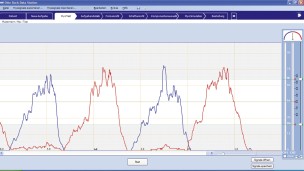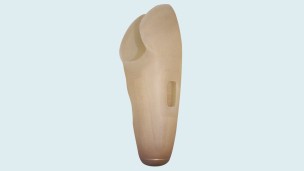Myoelectric Upper Limb Prosthetics 101
Myoelectric prosthesesFor upper-limb amputees, myoelectric-controlled prostheses offer the ultimate combination of function and natural appearance. Designed to mimic human anatomy and motion, electronic components are the closest alternative to an anatomical hand or arm.
| ||
What is a Myoelectric prosthesis?“Myoelectric” is the term for electric properties of muscles. A myoelectric-controlled prosthesis is an externally powered artificial limb that you control with the electrical signals generated naturally by your own muscles. Hand, wrist and elbow myoelectric components are available. With amputations above the elbow, a “hybrid prosthesis” may combine myoelectric-controlled components with body-powered components to control shoulder and/or elbow function. A skin-like glove covers the prosthesis for a natural appearance. | ||
How does it work?A myoelectric prosthesis uses the existing muscles in your residual limb to control its functions. One or more sensors fabricated into the prosthetic socket receive electrical signals when you intentionally engage specific muscles in your residual limb. Sensors relay information to a controller, which translates the data into commands for the electric motors and moves your joints. If muscle signals cannot be used to control the prosthesis, you may be able to use switches with a rocker or pull-push or touch pad. | ||
 | The strength and speed of movements can be controlled by varying your muscle intensity. All of it happens in an instant. For those with damage to nerves or muscles in the residual limb or for people with no arms, muscles in the chest or back can be used to direct movements of a myoelectric prosthesis. When a myoelectric prosthesis has several joints, each joint might need to be controlled by the same muscle. Sequential control allows positioning of one joint at a time. For example, you might use a muscle contraction to signal the elbow to bend, then use another contraction to signal the hand to close. With AxonBus technology, however, it will soon be possible to control multiple joints simultaneously. | |
 | The power behind a myoelectric systemAlthough a myoelectric prosthesis is controlled by natural electricity generated by your own muscles, the system needs a battery to power motors and electronics, and batteries need charging. Some batteries need to be removed from the prosthesis for charging. With others, a cord from a charging unit can be plugged into the prosthesis. | |
A myoelectric prosthesis is connected to the residual limb via a custom fabricated socket. The user ‘pulls in’ to the unique socket with a donning sock, which creates suction and helps suspend the socket. Hybrid prostheses, which combine both myoelectric-controlled and body-powered components, is another option. A hybrid prosthesis may include a hand and wrist controlled that are myoelectrically along with an elbow that is controlled by a harness and cables worn on the torso and controlled by shoulder movements. Compared to a traditional body-powered prosthesis, a myoelectric-controlled arm provides greater comfort, more range of motion, a larger functional area, and a more natural appearance. It may, however, cost and weigh more. | ||
Prosthetic hands and terminal devicesBecause upper-limb prostheses can end with a variety of artificial replacements for a hand, prosthetists refer to this broad assortment as “terminal devices”. With myoelectric prostheses, the options generally fall under these two categories: | ||
 | Prosthetic handsThe human hand is one of our most complex body parts. A perfect interplay of nerves, tendons, muscles and bones makes it a remarkably versatile, precision instrument. Recreating as many of its numerous functions as possible is one of the greatest challenges for medical technology. | |
Myoelectric hands may feature:
| ||
Terminal devices: GreiferA Greifer is a powerful, highly functional terminal device made by Ottobock. Designed to perform gripping applications, it excels at manual labor and other tasks. Features may include: Control of grip speed and grip force
| Myoelectric wristsMyoelectric-controlled wrists make it easier to grip and control objects close to the body. They also limit compensating movements you may make with your shoulder and the rest of your body—allowing you to move more naturally. Capabilities may include:
| Prosthetic ElbowsMyoelectric-controlled elbows, which typically include a forearm, flex and extend so you can do more without unnatural compensating movements. Capabilities may include:
|
